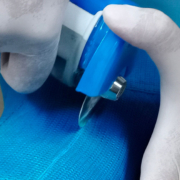Diisocyanates in the Healthcare Setting
As healthcare settings are moving away from plaster of Paris products to synthetic products there is an increased risk to staff exposure to diisocyanates, which are present in the resins and other products used within departments such as fracture clinics and prosthetic laboratories.
The British Orthopaedic Association (BOA) has adopted guidance from the European Union which introduced mandatory training for workers from August 2023.
The BOA Casting Sub Committee recommends that all healthcare professional who use synthetic casting and splinting materials contact their casting material suppliers in order to undertake product safety and education training to comply with UK REACH regulations.[1]
Further to training, the law requires you to adequately control exposure to materials in the workplace that cause ill health. This is the Control of Substances Hazardous to Health Regulations (COSHH).
The DFG BAT Biological Tolerance Value for HDI is 15µg/g (approx. 15µmol/mol creatinine) and for MDI is 10µg/L (approx. 4µmol/mol creatinine). [2]
Monitoring for Diisocyanates
A case study carried out in in 19 French polyurethane industries has shown that total MDA in post-shift urine samples is a reliable biomarker to assess occupational exposure to methylene diphenyl diisocyanate (MDI) in various industrial applications. [3]
The Health and Safety Executive HSE and British Occupation Hygiene Society BOHS have each produced guidance on biological monitoring.
This is designed to ensure that even with adequate training and control measures in place, staff are not exposed to excessive levels of hexamethylene diisocyanate (HDI), methylene diphenyl diisocyanate (MDI), toluene diisocyanate (TDI) and isophorone diisocyanate (IPDI).
Biological monitoring for chemicals helps prevent unacceptable health risks by providing information on the control of occupational exposure.
It can give an indication of absorption by all routes of exposure. Consequently, it is often used to complement personal air monitoring (which measures the concentration of a chemical in the air in a person’s breathing zone).
Therefore biological monitoring may be particularly useful for those chemicals which are easily absorbed through the skin or taken in by ingestion, or where exposure is controlled by personal protective equipment. [4]
Cairn Technology Monitoring
Cairn Technology has adopted biological monitoring to assist our healthcare customers in assuring that they comply with COSHH as set out above.
If you require further information on how we can assist you please do not hesitate to contact us at info@cairntechnology.com or call one of the team on 0333 015 4345 who will be happy to help.




